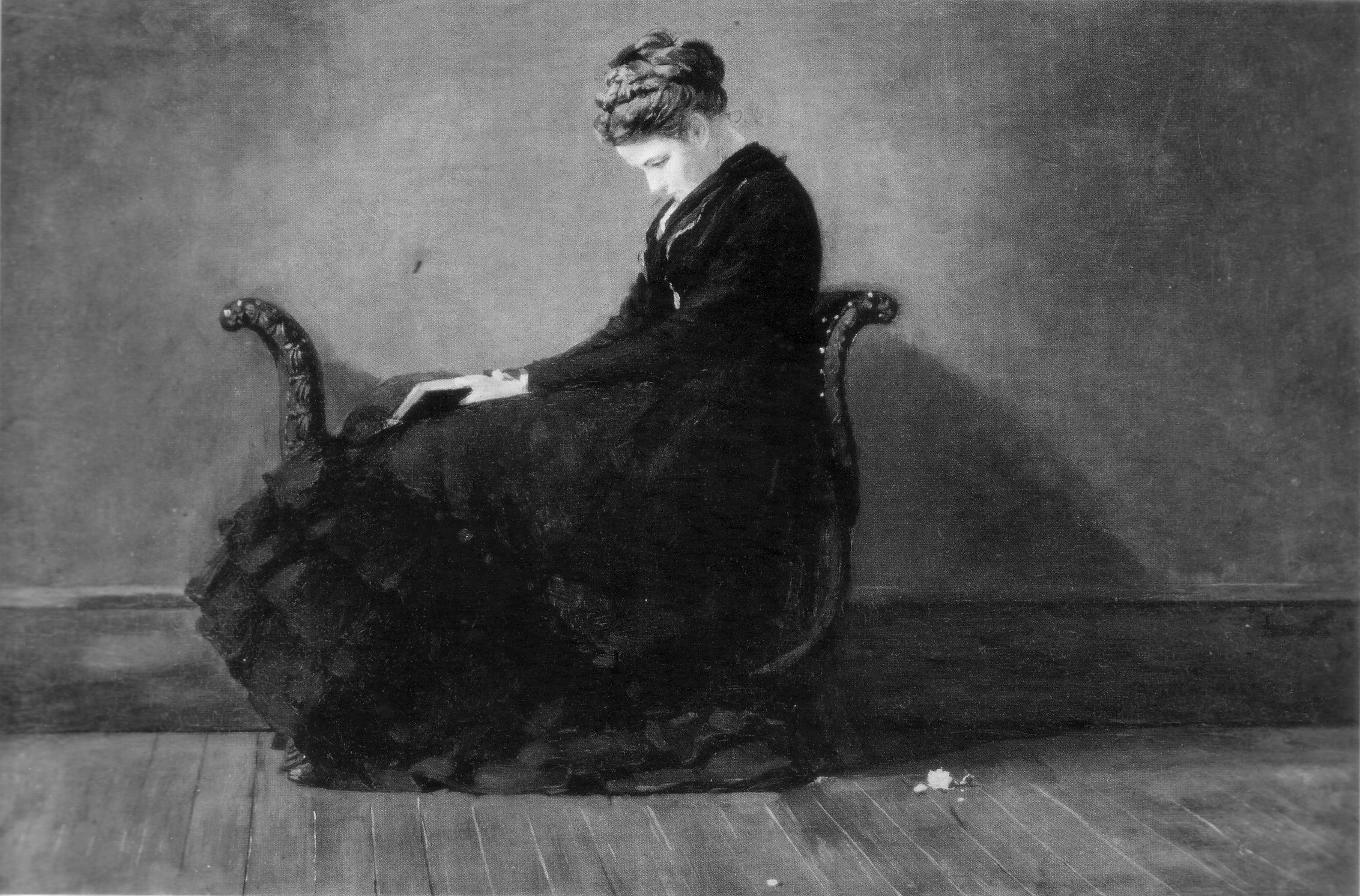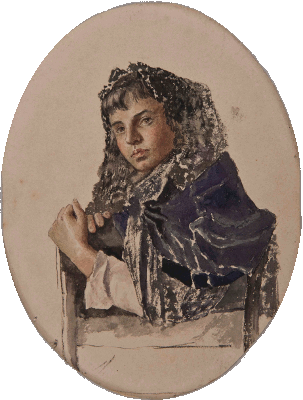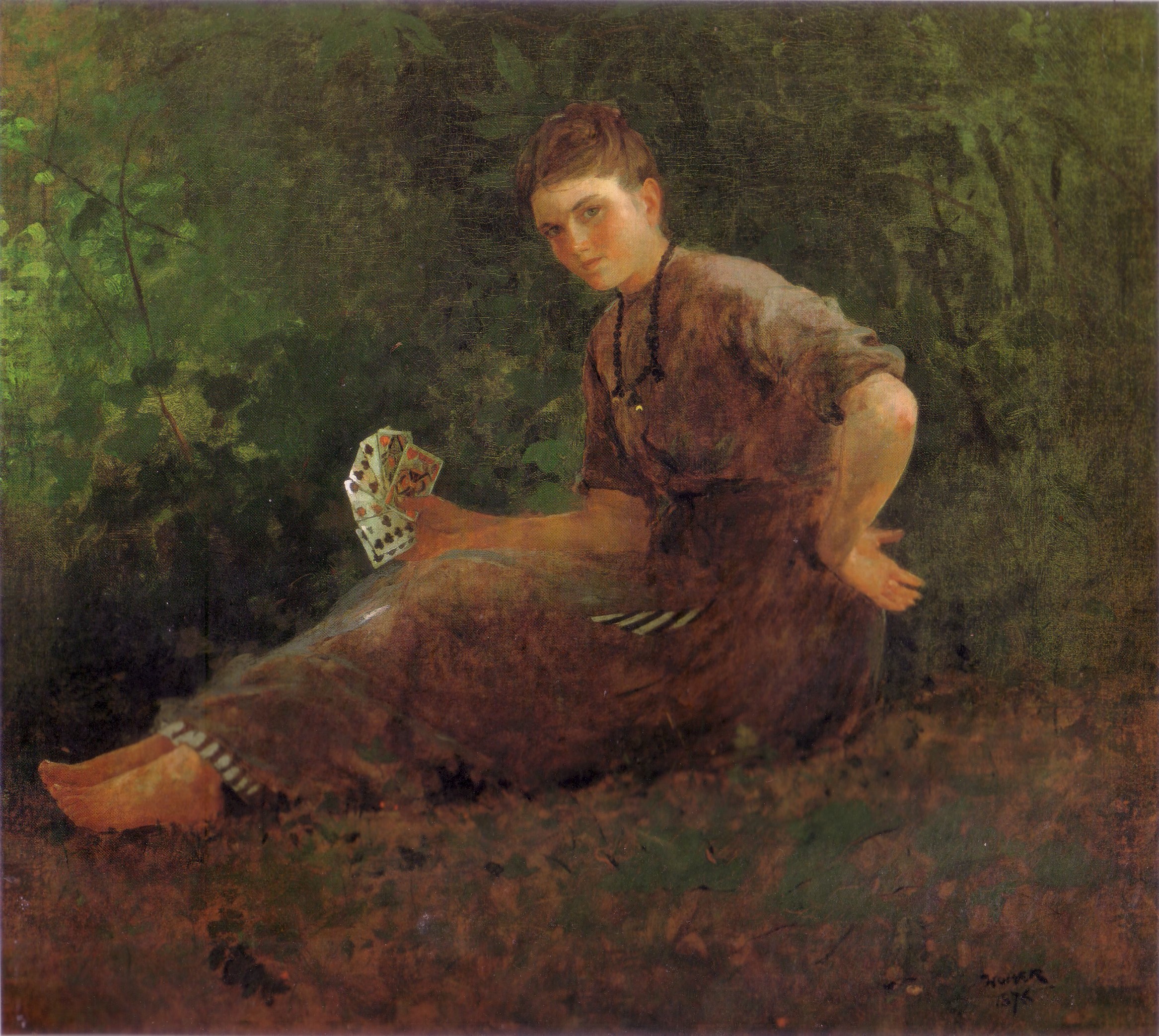In a nutshell – Winslow Homer has left us guessing – again – none of our
damned business anyway!
Winslow Homer was an intensely private individual; never a ladies' man,
nor a man about town - he was, above all else, a painter. As was
common among men of his time, he was a lifelong bachelor, never married, never engaged. What
little we know of Winslow Homer the man is obscured by time and speculation. We humans love a
mystery and abhor a vacuum; it's no surprise many have tried to fill in the blanks in whatever
love life Homer may or may not have had. This is an endeavor to let his private light shine
from under his proverbial bushel.

|

|

|
| Portrait of Helena de Kay | Young Woman with Mantilla | Shall I Tell Your Fortune? |
The young model portrayed as a barefooted gypsy fortune-teller in Homer's now
ambiguous 1876 oil Shall I Tell Your Fortune? (to some. it is
his legendary "mystery woman") –
she and the young model in the found watercolor Young Woman with Mantilla are in all
probability the same person, and chances are “she” was Winslow Homer's other
dream lover –
Helena de Kay being decidedly his first choice. Dream lovers because no socially-recognized
relationship
between either couple could or would ever be consummated: Helena de Kay had preferred the
rival suitor, and the historically elusive fortune-teller (arguably a Gloucester-Portuguese
girl), her doubtless ethnic Roman Catholic sphere a world apart and
incompatible with his old New England family and Congregationalist Church upbringing. Perhaps,
indeed, Shall I Tell Your Fortune? is founded in Homer‘s own predicament; an unattainable
marriage on one hand, an unacceptable match on the other. It has been intimated to this writer
that Shall I Tell Your Fortune?, is in fact, Homer's “crisis painting."
Consider when, in December 1872, wholly jilted out of illusionary dreams of love-and-
marriage with the ideal but socially up-market Helena de Kay, a devastated Homer pleaded: "I
am very jolly. no more long faces, it is not all wrong.”
But to no avail - reticent love...with an
added sting: the reluctance of his “runaway apprentice” (Helena) to personally collect his telling
gift – her now-famous portrait: Homer, now sulking, “Go and see your clever picture.
It was painted for you to look at.”
Yet. alas. in June 1874, Helena marries writer/editor Richard W. Gilder. Sometime after this
jolt. still on rebound, ready-or-not, Homer encounters – or re-encounters – dream lover number
two; an exotic young Portuguese girl; and he paints the thought-provoking Shall I Tell Your
Fortune? Gordon Hendricks intimates their meeting about 1876, perhaps aboard rail to or from Leeds,
NY – but possibly they were introduced, or, he became aware of her three years earlier. during his
first watercolor sojourn at Gloucester the summer of 1873. Particularly smitten once again,
whether reciprocally we may never know, yet, in all probability, a deep-seated Yankee-imbued
common sense trumped any reckless notion of pursuing an inevitably foolish and, according to
Shall I Tell Your Fortune?’s seven-card “horseshoe of fate", ill-fated autumn/spring
relationship. (See Part II of this article).
Homer, now forty, found himself romantically wounded. heart-sick, and bereft of consolation
from any foreseeable other. Juxtapose this irksome and crucially inauspicious twice-bitten,
thrice-shy loves-lost scenario in the light of Homer’s well-established ultra-fastidious
private nature. Consider his habitual quest for capital security, and debate this
speculation if you choose: Was he ever
financially a marriage prospect? For Homer, love in a cottage, with nothing but a crust &
etc., was never an option. Mr. Winslow’s private life, for all its romantic worth. would end
pretty much the way it had begun – that of a fundamentally dyed-in-the-wool Yankee
deeply rooted and steeped in the moral proprieties and constrictions of those American
Victorian times: any future diversions from his work other than naturally refined and morally
uplifted behavior seems highly unlikely.
Plausibly, sentiments of romantic true loves lost, one bitter and one bittersweet, are the
root cause of Homer’s standoffishness, branding him as distrustful of and diffident toward
women, especially society types. While a younger Homer avowed a certain fondness for pretty
girls, his later determined bachelor status was a common and far from unnatural condition for
many in his day, in all social classes. Now free, the ever-prudent Homer, fortified with a little
bourbon, enjoyed his own good company just fine: his beloved brother Charles, their fishing
trips, sister-in-law Mattie, and all the family, solitary nights notwithstanding. This would seem a
very characteristic finale to his private life story.
Unsettlingly, some art historians and Homer academics, particularly Henry Adams’s "The
Identity of Winslow Homer's 'Mystery Woman'" (Burlington Magazine, April 1990) and Dr.
Randall Griffin (Winslow Homer: An American Vision, July 1, 2006), have not perceived and
seem hard put to credit a chaste, craftsmanly Winslow Homer, and instead imply strange
goings-on, ignorant of Homer's possibly lusterless libido. Griffin re-embroiders Adams’s original
misperception: a facade of androgyny which impugns the young model
portraying the fortune-teller girl as imposter, inferring a young. adolescent male, serving to
further Adams's conjectures regarding Homer’s sexual orientation. Supposedly, in one recorded
incident attested to by the model – apparently unable to secure a female model. Homer did coax
and pay a youth, one Joseph Keenan, to pose in a landscape in
frock and bonnet at a distance, with body and face turned away from the viewer –
although such a work remains unidentified. Keenan, who did
pose for Blueboy, could have posed for two works within a five-day period in 1873.
One would have no problem with this rare, if not unique, make-do model,
as it appears quite obvious from his overall range and variety of models that the
resolute Winslow Homer was not particularly at a loss when it came to securing them:
ever observant, he likely had his pick. Regardless, Shall I Tell Your Fortune? is
securely dated '1876' and so with all certainty Keenan was not the model.
Decidedly, some earlier recorded references to this quite comely fortune-teller girl, the
"mystery woman" from Shall I Tell Your Fortune?, appear at odds with Adams's and Griffin's
perception; Homer scholar J. A. Philpott calls her a "good looking young woman” and Homer
scholar Lloyd Goodrich extols her as "a brown-haired girl with dark eyes and a vivacious face
full of character—looking straight at the spectator." They both proclaim her notably attractive
countenance – or, were they, are we, being fooled? Look closely at the models for
Young Woman with Mantilla and Shall I Tell Your Fortune?; both are portraits
which engage the viewer’s interest through the eyes of the artist, and each suits the
Philpott and Goodrich descriptions to a "T"
(for True femme fatale)!
Homer would not part with his oil on canvas Shall I Tell Your Fortune?; cherished, it
resided on- and off-easel in his studio until his death 35 years later. One wonders, given his
verifiable attachment to the fortune-teller’s image, if, when Shall I Tell Your Fortune? was
exhibited at the Century Club in 1877 and again at the Academy in 1878, where it gamered vapid
criticism, did the painting carry the aitist’s notation: 'Not for sale' – and that the depicted suite of
cards conveyed a message; (to Helena Gilder née de Kay...perhaps? ...it advertises purpose;
card reading blossomed among the genteel during this era).
Regardfully, if Shall I Tell Your Fortune? has been misinterpreted, even slighted as
an androgynous hot-potato, or some such, surely by now, with or without the re-emergence of
the fortune-teller girl — in a fine black lace mantilla — she demands clarification.
So, a barefooted boy in drag? — let's not wager the farm. Henry Adams, Dr. Griffin's credited source, spins of
whole-cloth his odd perception of veiled masculinity. He (Adams) concludes "...there can be
little doubt that Homer's 'mystery woman' was a man." Adams offers that it was seen as more
proper to go off into the woods with a boy in drag than with a young woman unchaperoned!
Adams fosters quasi-references to Homer’s "somewhat inverted sexual attitudes," but
(thankfully!) he concedes: "I do not find it credible that Homer became sexually involved with
Joseph Keeenan."
While difficult enough to imagine that the fortune-tellers's
fully female form is modeled by an adolescent youth, Adams doggedly weaves in two more
loosely-knit proposals; that the models for at least two watercolors from the so-called "red-haired
girl" series, namely Reading and Girl with Porcelain Elephant are also none
other than adolescent males posing in drag! Adams‘s visual evidence to support this claim: the
reclining figure in Reading has "over-developed neck muscles" (?) and. due to Homer's "lack of
interest in portraiture” (again. Adams's view): the Reading model's face can be read as that of the
aforementioned boy, Joseph Keenan. (See Adams. Burlington Magazine, April 1990.)
Adams goes on to discern peculiarities of non-feminine deportment in the Girl
with Porcelain Elephant. Adams sees and says of her: hunched in unfeminine posture and
glowering over the figural bric-a-brac "it’s clear that Homer was rendering not a woman but a
boy in girls' clothes." Apparently Adams sees through this masquerade in the same manner as
the crafty Mrs. Judith Loftus of Huck Finn’s Sarah Mary Williams fame – only Mrs. Judith Loftus
had a heap more common sense ‘bout a young girl's skirt! Here Homer is observed
working on a challenging and recurrent, if rarely remarked-upon, pictorial element: that of a young
woman’s well-shod feet assuming a comfortable position among her skirts. This early-on and
continuous watercolor endeavor formulates during The Farmyard Wall, Girls with Lobsters and
In Charge of Baby (all 1873), reconfigures in 1874's Looking for Eggs and 1875’s Girl with
Straw in her Mouth, then presents with mostly greater than lesser success throughout the red-
haired girl series and Houghton Farm (1876-1879) to Girl on Beach and The Garden Wall (both
1880). Finally in the new decade, it runs its course at Cullercoats/Tynemouth (1881-82) where
it thrives amongst the fisher girls and, for the most part, resolves itself beautifully.
Skillfully quick-drawing watercolors from life we can only appreciate – and accept;
"Homer’s watercolor hand reproduced with sympathy or satire" and the occasional idio-optical
'tilt'...as seen here, for example, in Girl with Porcelain Elephant where he's probably
poking fun at the artificial trends and
restrictive fashions of the aesthetic movement: Mindfully preoccupied with the bric-a-brac, her
implausibly crossed legs tucked backward and catawampus between the stool and table base,
her checkered petticoats exposed and long velvet frock buttoned obliquely down the front may
appear in an odd twist, but need not be in question – She is a she,
and ditto for the model in Reading. And by the way, did you notice the table's
vanished foot?
To Griffin, spurred by Adams’s original misperception, the fortune-teller is a male in
drag. and as such, surely indicative of certain homoerotic persuasions on Homer's part. Yet
Adams recants regarding the fortune-teller’s persona. regroups. and aims his “males in drag"
accusations at the models in Reading and Girl with Porcelain Elephant: Adams’s theory foregoes
any rationale for the assertion of “males in drag." Adams's contention is then debunked by Griffin
who says that the model posed in Reading is an "attractive woman." Dare one ask about the other
portrayals in the "red haired girl" series. including Blackboard and Lemon? Are they really
girls?, or really boys...with wide hips? If girls. are they all the same girl? And what to make of
the pair of red-haired figures posed upon the infamously tilted (i.e. two-legged) settee featured in
Backgammon, the model on the right further tilted by basketball player-length thighs? To witness
what is probably the artist's most curious idio-optical “tilt” see l873’s watercolor Watching the
Harbor: Homer has fixed upon that lad – two right feet!
By way of ideologically combined misperceptions of three inconsistent figure studies,
Adams and Griffin have further misconstrued our Yankee
artist’s prudential, if ironic nature and
conjured their "revealing, and in many respects unsettling record of Homer’s confused and
ambivalent sexual feelings." To the contrary, here Adams and Griffin (among others) indulge in speculations
irrelevant in the main. Not primarily a portraitist, Homer, absent occasions of burning empathy
is, in truth, objective, but somehow provincial – an observer rather than a possessor.
Although brief works are well-resolved moments out of time – essence not essay, some of
Homer’s watercolor
compositions are tilted-to-work in accordance with his idio-optical see-and-say-so: most are
also well-resolved – some few, less so. Note Homer's "appetite for the isolated figure, search for truth of pose
even at the price of obvious grace, love of aberrant perspectives and marriage of sharp
observation and decorative patterning"... this is our self-taught
Yankee artist at work: second guess him at your own risk.
So now, if it’s all or nothing, let us continue to risk the smoke of Mr. Winslow’s utterly
delitescent love-life. While the Portrait of Helena de Kay (o/c ca. 1872) was not publicly
exhibited until
1936 and thus never subject to contemporary criticism (except perhaps in the Gilder family
circle), recent Homer scholarship discusses comparative aspects of the portrait of Whistler’s
Mother and the Portrait of Helena de Kay yet Shall I Tell Your Fortune? remains virtually
unattended-to save for one small mention which reinforces the fortune-teller’s image in
accord with Goodrich and Philpott as one of [Homer's] "alluring images of
women." (See M. Conrad Winslow Homer and the Critics.)
Only one Homer scholar alludes to Helena de Kay as a recurring figure model in
Homer’s early 1870s oil sketches; The Butterfly, Waiting for an Answer, Girl in the Orchard and
Summer Afternoon, for example. Sarah Burns acknowledges her in “The Courtship of Winslow
Homer” (The Magazine Antiques, 2/2002); stating, among those several studies of Helena de
Kay, one in particular, Girl in the Orchard (o/c, 1874) "...suggests that at some level Homer
never ceased to regret his failure to make Helena de Kay his wife." Yet, in other works, The
Rustics (o/c), Rustic Courtship (w/c), both 1874, and in particular, the now unlocated Course of
True Love (o/c, 1875) “...the fact that Homer recast de Kay as a housemaid or a blowsy country
lass is indicative of his desire to distance and protect himself from painful memories.” Burns
writes: [Homer] "...kept this painting, Girl in the Orchard, all his life" and when in 1901 he had
a cottage raised at Kettle Cove, within the Maine family compound, he hung this haunting, solitary
image of "Saint Helena" (see Mary Hallock’s 1873 letter to Richard Gilder): in that cottage – a
place Homer mused he’d spend his final years and he even declared "other men build houses to
live in, I build this one to die in." No doubt Burns is right – the jilting by Helena de Kay scarred
Homer to "the bottom of his soul." But characteristically, Homer‘s
Yankee disciplined romantic nature portends – he had that cottage built to finalize his
never-realized dream: "Mr. and Mrs." Winslow
and Helena de Kay Homer; adequately furnished, the
picture hung (among other disappointments), he closed the door and never lived there. Ever prudent Homer had finally crafted
his inevitable resolution...that dream’s mausoleum – and a fine rental income property – rent it he
did... die there, he did not.
In September 1910, on the 29th day at 1:30 pm, Winslow Homer was fatally gripped by
severe internal hemorrhage and stroke, and passed away – at Prout’s Neck studio – his real home.
His two beloved brothers, Charles and Arthur, were with him, as was his surely then "on-easel"
portrait of the fortune-teller girl – his "mystery woman," arguably his truest dream lover. If
we are to trust the Homer canon that, "In his own way, Homer is in effect telling us that we
should scrutinize his art for the revelations of his life, the expressions of his innermost feelings
and ideas," then it stands to romantic reason that the fortune-teller’s enduring
presence...message...
In retrospect, we could reasonably conclude, that while one might to a larger degree
recognize Homer's rather tragic sense of idealized womanhood as he bestowed it upon divers
portrayals of his unattainable dream lover Helena de Kay; the light of Mr. Winslow’s truest,
perhaps more accommodating dream lover, can be glimpsed through she who is present in Shall I
Tell Your Fortune? and his captivating watercolor portrayal Young Woman with Mantilla. On the
other hand, the red-haired girl misinterpreted by Adams (among others) as the "mystery
woman," maintains a distance and detachment appropriate to that of a good amateur figure
model, who was no doubt properly respected, if admired, and certainly remunerated well for her
time spent posing, as was Homer’s apparent custom.
Finally, what indeed constitutes our historic perception of the private "Mr. Winslow"
Homer? Some known quantities: inherently noble; a life-long observer of early Victorian
proprieties, essentially self-taught and self-made, certifiably idiosyncratic,
arguably idio-optical,
known to be fiesty, cantankerous, and conceivably happiest when tent-dwelling; Homer kept the strictest
reserves on his private life and personal nature. As a virtual credo, this encompasses his essence
as an individual: Just consider how many artists of such national stature left no bona fide
self-portrait...our Yankee artist remains an enigma.
Shrouded in that timeless light and shadow he has
laid down for us, Winslow Homer’s appears an inherently conscious endeavor to create, live with and
enjoy, and, to all appearances, take away with him, an impeccable record – of a life well lived; a
life of highly reputable comportment.
In hazarding any speculation as to his sexual identity – deduced from his art – if Homer's
id does measurably exist in his more candidly laid down personal realities, then surely reflections
of a heterosexual, yet mostly abstinent life appears the safest of all bets.
-BC
-BC